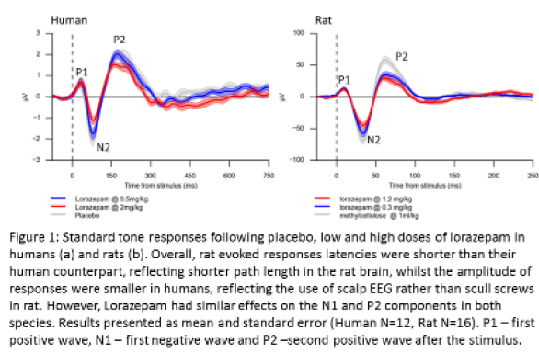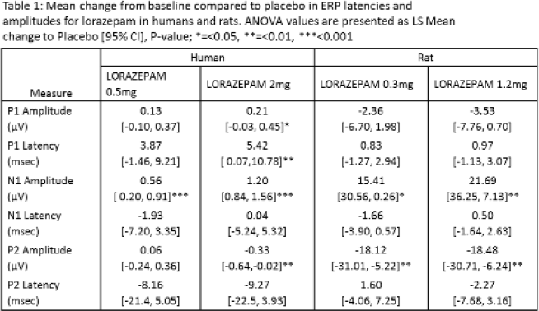Print version
Search Pub Med
| 093P London, UK Pharmacology 2017 |
Translational study of auditory event related potentials as a potential central nervous system biomarkers with lorazepam
Introduction: This study investigated the viability of auditory evoked related potentials (aERPs) as translational biomarkers of drug pharmacodynamics and target engagement. Concurrent within-subject PK/PD experiments in both humans and rats were performed to translate the effects of lorazepam on endpoints from aERPs.
Methods: Both human and rat studies were blind, randomised, placebo controlled 5-period, single-dose, crossovers with the exception that within the rat experiment an incomplete block design was used for PK sampling. EEG recordings were made in humans (N=12) (previously described (1)) and rats (N=16) (previously described (2)). An “oddball paradigm” was run with a standard (probability 0.9, 1000Hz, 50ms duration, 5ms rise/fall time, 90dB) and deviant tone (probability 0.1, 1000Hz, 50ms duration, 5ms rise/fall time, 70dB). The human trial occurred over 5.5 minutes resulting in 330 stimuli. In the rat, 1080 stimuli were presented over 20 minutes to ensure sufficient samples during wakefulness (determined via EEG/EMG) and 300/30 standard/oddball responses randomly selected. Two doses of lorazepam were selected based on plasma concentration (AUC) and ERPs were compared at Tmax (2 hours in humans (3) and 1 hour in rats (in-house data)). In humans, drug was administered as tablets whilst for rats; lorazepam was formulated in 1ml/kg pH-adjusted methycellulose 15 cP 0.25% and dosed via oral gavage.
Results: The morphology of rodent aERPs to standard tones matches well that of human aERPs. This study showed that in both rats and humans, lorazepam dose dependently decreased amplitudes of the N1 and P2 components of the standard tone response potential (Figure 1). Latencies to N1 and P2 components were not significantly altered in either species whilst the latency of the P1 component was significantly increased at the 2mg dose in humans only (Table 1). The effects of lorazepam showed a corresponding PK/PD relationship between species. Oddball responses were not elicited in rats and no comparisons made for this aspect of the paradigm.
Conclusions: In summary, these data show the potential for ERPs as low-cost, non-invasive translational measures in the development of drugs with targets in the central nervous system. As the oddball response was not elicited in rats, application of this method to standard tone responses limits the use of this paradigm to measures of sensory processing.
References:
(1) Anderer et al. (2002). Methods & findings in experimental and clinical pharmacology, 24, pp.121-138.
(2) McCarthy et al. (2017). Neuropharmacology, 108, pp.415-425(3) Berchou R et al., (1986). Clinical EEG, 17(4), pp176



